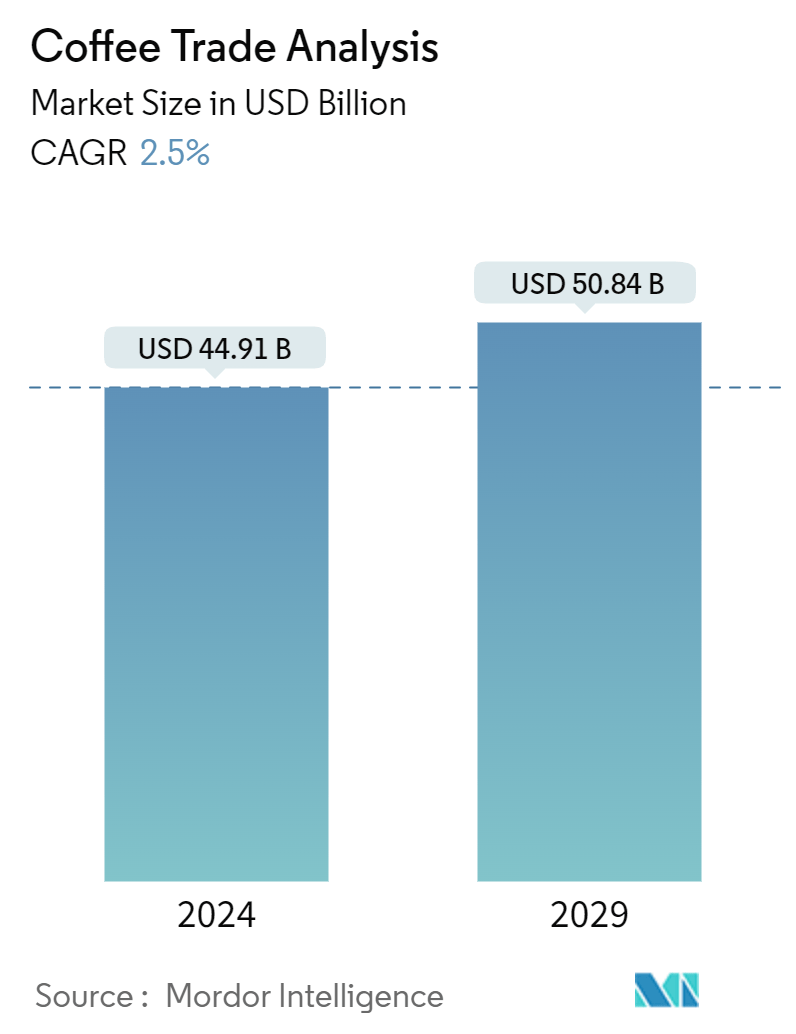Market Size of Coffee Trade Analysis

| Study Period | 2019 - 2029 |
| Market Size (2024) | USD 44.91 Billion |
| Market Size (2029) | USD 50.84 Billion |
| CAGR (2024 - 2029) | 2.50 % |
| Fastest Growing Market | Asia Pacific |
| Largest Market | Europe |
Coffee Trade Analysis Market Analysis
The Coffee Market size is estimated at USD 44.91 billion in 2024, and is expected to reach USD 50.84 billion by 2029, growing at a CAGR of 2.5% during the forecast period (2024-2029).
- Coffee is produced in more than 50 developing countries in South America, Africa, and Asia and is an essential source of income for more than 20-25 million families worldwide. According to estimates from the United States Department of Agriculture (USDA), global coffee production is set to rebound in the 2024/25 season, potentially invigorating the international coffee trade. This revival is primarily driven by Brazil's continued production recovery and a notable surge in output from Indonesia in 2024.
- The International Coffee Organization highlights that in 2024, coffee consumption is projected to increase by 2.2%, which will likely create a positive impact on the coffee trade. Also, after witnessing three consecutive years of decline, ending stocks are anticipated to experience a slight rise. In 2024, North America is projected to continue leading in coffee consumption globally, with an expected increase of 3.8%, totaling 30.9 million bags. Consequently, North America's global coffee consumption share is anticipated to rise to 17.5%, up from the previous 17.2%. Other regions are also projected to see increased consumption, albeit at a slower growth rate.
- In 2024, global economic growth is poised to decelerate, as underscored by the IMF's October 2023 economic outlook. This slowdown is likely shaping trends in coffee consumption. Although the increasing cost of living presents a challenge to purchasing coffee, there is an anticipated shift in consumer buying behavior, with individuals transitioning from premium brands to more budget-friendly coffee options.
Coffee Trade Analysis Industry Segmentation
Small and dark brown coffee beans are roasted and ground to brew coffee. The report offers a global trade analysis for coffee beans, whether or not they are roasted or decaffeinated. The coffee trade analysis is segmented by geography into North America, Europe, Asia-Pacific, South America, and Africa. The report offers an analysis of import (value and volume) and export (value and volume). The trade data and forecasts are reported in terms of value (USD) and volume (metric tons) for all the above segments.
| Geography (Import Analysis by Volume and Value and Export Analysis by Volume and Value) | ||||||||
| ||||||||
| ||||||||
| ||||||||
| ||||||||
|
Coffee Trade Analysis Size Summary
The coffee trade analysis market is experiencing steady growth, driven by its critical role in the economies of over fifty developing countries across South America, Africa, and Asia. Coffee production is labor-intensive, relying heavily on countries with abundant labor forces. The market is characterized by a complex interplay of factors, including global production and consumption trends, with significant contributions from Brazil, the United States, and the European Union. The coffee industry faces challenges such as poor labor practices, environmental concerns, and fluctuating prices, which impact its sustainability and profitability. Despite these challenges, the demand for coffee continues to rise, particularly in European countries, as consumers increasingly prioritize quality and sustainability in their coffee choices.
The global coffee market is further bolstered by evolving consumer preferences and lifestyle changes, with a growing inclination towards healthier options like green coffee. This shift is supported by the emergence of modern cafes and increased disposable incomes, which enhance consumer satisfaction and loyalty. Brazil remains a dominant player in the coffee trade, producing a significant portion of the world's coffee supply, primarily of the Arabica variety. The United States stands as the largest single buyer of coffee globally, with Brazil being a major exporter to the U.S. and other countries. Initiatives like the Indonesia Coffee Enterprise Resilience Initiative and Nestle's commitment to sustainable farming practices highlight ongoing efforts to enhance the sustainability and resilience of the coffee supply chain, ensuring its continued growth and relevance in the global market.
Coffee Trade Analysis Market Size - Table of Contents
-
1. MARKET DYNAMICS
-
1.1 Market Overview
-
1.2 Market Drivers
-
1.3 Market Restraints
-
1.4 Value Chain Analysis
-
-
2. MARKET SEGMENTATION
-
2.1 Geography (Import Analysis by Volume and Value and Export Analysis by Volume and Value)
-
2.1.1 North America
-
2.1.1.1 United States
-
2.1.1.2 Canada
-
2.1.1.3 Mexico
-
-
2.1.2 Europe
-
2.1.2.1 United Kingdom
-
2.1.2.2 Denmark
-
2.1.2.3 Netherlands
-
2.1.2.4 Germany
-
2.1.2.5 Norway
-
2.1.2.6 Sweden
-
-
2.1.3 Asia-Pacific
-
2.1.3.1 China
-
2.1.3.2 India
-
2.1.3.3 Japan
-
2.1.3.4 Indonesia
-
2.1.3.5 Philippines
-
-
2.1.4 South America
-
2.1.4.1 Brazil
-
2.1.4.2 Argentina
-
-
2.1.5 Africa
-
2.1.5.1 South Africa
-
-
-
Coffee Trade Analysis Market Size FAQs
How big is the Coffee Market?
The Coffee Market size is expected to reach USD 44.91 billion in 2024 and grow at a CAGR of 2.5% to reach USD 50.84 billion by 2029.
What is the current Coffee Market size?
In 2024, the Coffee Market size is expected to reach USD 44.91 billion.

